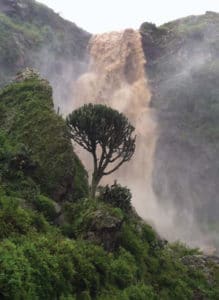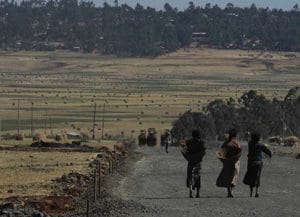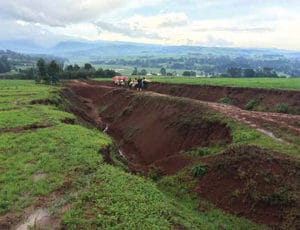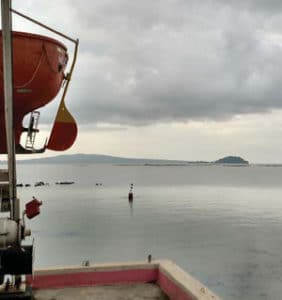NILE-NEXUS: Opportunities for a Sustainable Food-Energy-Water Future in the Blue Nile Mountains of Ethiopia
[caption id="attachment_2361" align="alignleft" width="219"] Figure 1. Waterfall in the Blue Nile Mountains. Photo: Jose Molina.
Figure 1. Waterfall in the Blue Nile Mountains. Photo: Jose Molina.
I first met Belay Simane at a United Nations negotiation in Germany. We were both on government delegations to the United Nations Framework Convention on Climate Change and during one of the many, many procedural delays we struck up conversation. It turned out neither of us were full-time negotiators. In fact, we were both researchers, and we were both looking at the same place but from very different scales. Belay is an agronomist, and he’d spent years working with farming communities of the Blue Nile Mountains of Ethiopia to advance household and village level climate resilience. I am a climate scientist and hydrologist, and I’d been working with NASA to study transboundary flows across the Nile basin with satellites and regional models. Over several cups of overpriced conference hall coffee, we began a discussion that has occupied both of us over the six years since: how can we understand, quantify, and, ultimately, contribute to optimal solutions for the multi-scale environment and development challenges that face the Nile, from
household to basin? The Belmont Forum NILE-NEXUS project is founded on this question.
[caption id="attachment_2360" align="alignright" width="300"] Figure 2. Harvest season in the Blue Nile Mountains. Photo: Ben Zaitchik.
Figure 2. Harvest season in the Blue Nile Mountains. Photo: Ben Zaitchik.
Like mountainous regions around the world, the highlands of Ethiopia are stunningly beautiful (Fig. 1). They are also climatically and ecologically diverse, and the conditions in the highlands are critically important for human population centers downstream. But the Blue Nile Highlands also differ from many other mountainous regions in that they are densely populated, with villages, agriculture, and pastoral activities extending nearly to the highest mountain peaks. This sets up a complex, multi-scale dynamic for resource management in the area. Smallholder, primarily subsistence-based, farming communities cover the highlands (Fig. 2). Rapid population growth and declining soil fertility conditions have driven deforestation and tightening resource scarcity, which in turn contribute to some of the highest erosion rates in the world (Fig. 3). This causes a poverty trap for many in the highlands and degrades downstream water value. But at a larger scale, the Blue Nile basin is central to ambitious national and regional development plans. These plans include the biggest hydropower dam in Africa (the Grand Ethiopian Renaissance Dam, currently under construction), work to improve productivity of irrigated agriculture in lowland Sudan and on into Egypt, and continued efforts to form satisfying transboundary water agreements and mutually beneficial electric grid interconnections.
[caption id="attachment_2359" align="alignleft" width="300"] Figure 3. Gully erosion. Photo: Sara Rasmussen.
Figure 3. Gully erosion. Photo: Sara Rasmussen.
This is a complex problem, and it demands an interdisciplinary and creative research approach. For NILE-NEXUS, we’ve assembled a team that includes experts in social dynamics of rural development (Detlef Muller-Mahn, University of Bonn), smallholder agricultural economics (Jeremy Foltz, University of Wisconsin), Nile basin hydropower (Paul Block, University of Wisconsin), highland biodiversity (Andrea Sciarretta, University of Molise), and integrated socio-ecological systems modeling (Gianni Gilioli, Universita di Brescia). Each of us had worked on interdisciplinary projects before, but the range of disciplines, language, and time zones on the NILE-NEXUS team has brought us all of the excitement and all of the maddening challenges that come with integrating diverse perspectives and different (disciplinary) languages.
[caption id="attachment_2362" align="alignright" width="282"] Figure 4. Lake Tana, at the headwaters of the Blue Nile River. Photo: Ben Zaitchik.
Figure 4. Lake Tana, at the headwaters of the Blue Nile River. Photo: Ben Zaitchik.
The NILE-NEXUS team met in person for the first time this past July on the banks of Lake Tana, at the center of the Blue Nile highlands (Fig. 4). We met with local collaborators, made student advising commitments at the local university (Bahir Dar University), and visited candidate study villages. The result of this meeting was a draft for an integrating social-ecological systems model designed to capture multi-scale food energy and water dynamics. Not surprisingly, we came away with more questions than answers. How will we quantify social dynamics for integrated modeling? Which aspects of biodiversity can we measure and monitor? How will we capture decision making processes and development opportunities across a huge, culturally diverse and rapidly evolving basin?
Moving forward, our team will fan out over the mountains to find answers to these questions. Transects designed to capture the topographic and cultural diversity of the basin are underway for soils, cropping systems, and biodiversity. Focused erosion studies will begin in 2017, as will interviews and surveys in villages
affected by dams and irrigation developments. Observations and models are being integrated to generate retrospective climate and stream ow reconstructions, which will in turn be rolled forward as climate projections. Hydropower sensitivity to climate and reservoir operation is being examined with hydroeconomic models, and field data on crop production are being applied to calibrate process-based agricultural models. It’s a dizzying number of tasks, and each has its own research questions and complications. Ultimately, we will bring all of these studies together to answer our guiding question: what options exist to address emerging food-energy-water risks and opportunities in a rapidly changing tropical mountain system in coming decades, and what roles do local, regional, and national interests and actors play in the selection of these options?
 When we meet again in the Blue Nile Mountains in 2017, we hope to be closer to answering that question.
When we meet again in the Blue Nile Mountains in 2017, we hope to be closer to answering that question.
Author: Ben Zaitchik, Johns Hopkins University
Project Partners: Jeremy Foltz (1), Paul Block(2), Detlef Mueller-Mahn(3), Gianni Gilioli (4), Andrea Sciarretta (5), and Belay Simane (6)
(1) University of Wisconsin-Madison; (2) University of Wisconsin- Madison; (3) University of Bonn, Germany; (4) Universita di Brescia, Italy; (5) University of Molise, Italy; (6) Addis Ababa University, Ethiopia
 Figure 1. Waterfall in the Blue Nile Mountains. Photo: Jose Molina.
Figure 1. Waterfall in the Blue Nile Mountains. Photo: Jose Molina.I first met Belay Simane at a United Nations negotiation in Germany. We were both on government delegations to the United Nations Framework Convention on Climate Change and during one of the many, many procedural delays we struck up conversation. It turned out neither of us were full-time negotiators. In fact, we were both researchers, and we were both looking at the same place but from very different scales. Belay is an agronomist, and he’d spent years working with farming communities of the Blue Nile Mountains of Ethiopia to advance household and village level climate resilience. I am a climate scientist and hydrologist, and I’d been working with NASA to study transboundary flows across the Nile basin with satellites and regional models. Over several cups of overpriced conference hall coffee, we began a discussion that has occupied both of us over the six years since: how can we understand, quantify, and, ultimately, contribute to optimal solutions for the multi-scale environment and development challenges that face the Nile, from
household to basin? The Belmont Forum NILE-NEXUS project is founded on this question.
[caption id="attachment_2360" align="alignright" width="300"]
 Figure 2. Harvest season in the Blue Nile Mountains. Photo: Ben Zaitchik.
Figure 2. Harvest season in the Blue Nile Mountains. Photo: Ben Zaitchik.Like mountainous regions around the world, the highlands of Ethiopia are stunningly beautiful (Fig. 1). They are also climatically and ecologically diverse, and the conditions in the highlands are critically important for human population centers downstream. But the Blue Nile Highlands also differ from many other mountainous regions in that they are densely populated, with villages, agriculture, and pastoral activities extending nearly to the highest mountain peaks. This sets up a complex, multi-scale dynamic for resource management in the area. Smallholder, primarily subsistence-based, farming communities cover the highlands (Fig. 2). Rapid population growth and declining soil fertility conditions have driven deforestation and tightening resource scarcity, which in turn contribute to some of the highest erosion rates in the world (Fig. 3). This causes a poverty trap for many in the highlands and degrades downstream water value. But at a larger scale, the Blue Nile basin is central to ambitious national and regional development plans. These plans include the biggest hydropower dam in Africa (the Grand Ethiopian Renaissance Dam, currently under construction), work to improve productivity of irrigated agriculture in lowland Sudan and on into Egypt, and continued efforts to form satisfying transboundary water agreements and mutually beneficial electric grid interconnections.
[caption id="attachment_2359" align="alignleft" width="300"]
 Figure 3. Gully erosion. Photo: Sara Rasmussen.
Figure 3. Gully erosion. Photo: Sara Rasmussen.This is a complex problem, and it demands an interdisciplinary and creative research approach. For NILE-NEXUS, we’ve assembled a team that includes experts in social dynamics of rural development (Detlef Muller-Mahn, University of Bonn), smallholder agricultural economics (Jeremy Foltz, University of Wisconsin), Nile basin hydropower (Paul Block, University of Wisconsin), highland biodiversity (Andrea Sciarretta, University of Molise), and integrated socio-ecological systems modeling (Gianni Gilioli, Universita di Brescia). Each of us had worked on interdisciplinary projects before, but the range of disciplines, language, and time zones on the NILE-NEXUS team has brought us all of the excitement and all of the maddening challenges that come with integrating diverse perspectives and different (disciplinary) languages.
[caption id="attachment_2362" align="alignright" width="282"]
 Figure 4. Lake Tana, at the headwaters of the Blue Nile River. Photo: Ben Zaitchik.
Figure 4. Lake Tana, at the headwaters of the Blue Nile River. Photo: Ben Zaitchik.The NILE-NEXUS team met in person for the first time this past July on the banks of Lake Tana, at the center of the Blue Nile highlands (Fig. 4). We met with local collaborators, made student advising commitments at the local university (Bahir Dar University), and visited candidate study villages. The result of this meeting was a draft for an integrating social-ecological systems model designed to capture multi-scale food energy and water dynamics. Not surprisingly, we came away with more questions than answers. How will we quantify social dynamics for integrated modeling? Which aspects of biodiversity can we measure and monitor? How will we capture decision making processes and development opportunities across a huge, culturally diverse and rapidly evolving basin?
Moving forward, our team will fan out over the mountains to find answers to these questions. Transects designed to capture the topographic and cultural diversity of the basin are underway for soils, cropping systems, and biodiversity. Focused erosion studies will begin in 2017, as will interviews and surveys in villages
affected by dams and irrigation developments. Observations and models are being integrated to generate retrospective climate and stream ow reconstructions, which will in turn be rolled forward as climate projections. Hydropower sensitivity to climate and reservoir operation is being examined with hydroeconomic models, and field data on crop production are being applied to calibrate process-based agricultural models. It’s a dizzying number of tasks, and each has its own research questions and complications. Ultimately, we will bring all of these studies together to answer our guiding question: what options exist to address emerging food-energy-water risks and opportunities in a rapidly changing tropical mountain system in coming decades, and what roles do local, regional, and national interests and actors play in the selection of these options?
 When we meet again in the Blue Nile Mountains in 2017, we hope to be closer to answering that question.
When we meet again in the Blue Nile Mountains in 2017, we hope to be closer to answering that question.Author: Ben Zaitchik, Johns Hopkins University
Project Partners: Jeremy Foltz (1), Paul Block(2), Detlef Mueller-Mahn(3), Gianni Gilioli (4), Andrea Sciarretta (5), and Belay Simane (6)
(1) University of Wisconsin-Madison; (2) University of Wisconsin- Madison; (3) University of Bonn, Germany; (4) Universita di Brescia, Italy; (5) University of Molise, Italy; (6) Addis Ababa University, Ethiopia
Related Posts
By accepting you will be accessing a service provided by a third-party external to https://www.mountainresearchinitiative.org/







